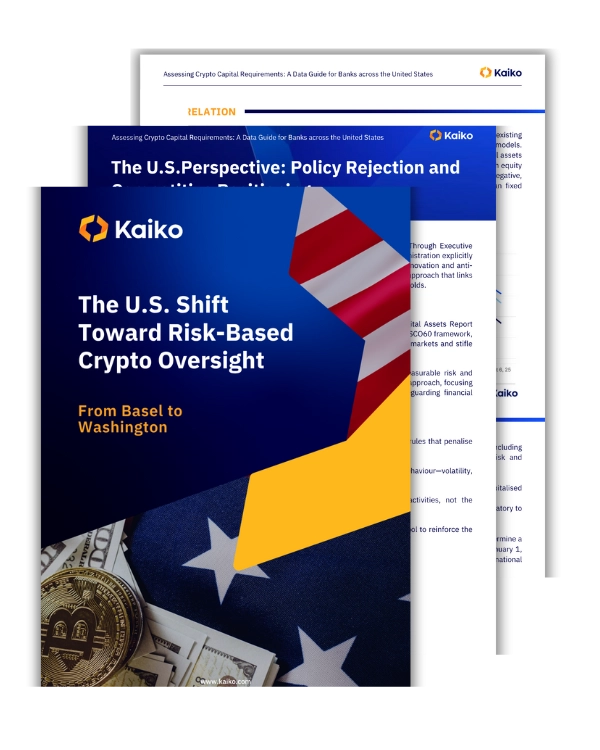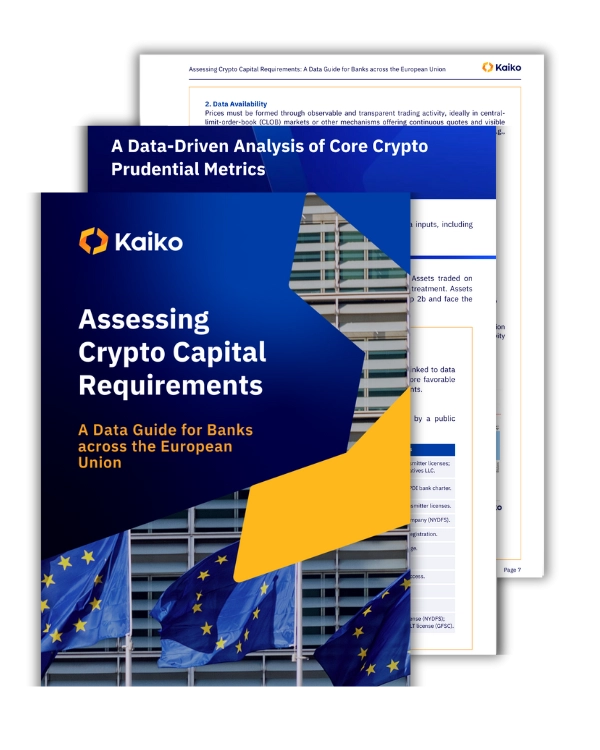We're hiring! Discover our culture and explore open roles.

EU vs US: Two Paths for Prudential Crypto Rules
With the Basel SCO60 implementation deadline approaching in 2026, a clear regulatory split is emerging between the European Union and the United States. Both regimes have indicated their intention to push forward with their own plans when it comes to prudential crypto rules and regulating banks’ crypto exposure. This is set to mark the first major divergence in how large economies intend to address institutional crypto exposure, and has the potential to significantly influence the digital asset landscape.
While the EU is doubling down on containment and caution, the US is charting a course that prioritizes innovation and global competitiveness. As a result, US banks are likely to benefit from lighter capital requirements, while their European counterparts face a stricter prudential burden. Regardless of the winners and losers, this course is set to lead to fragmented global standards and new complexities for cross-border supervision.
This blog will quickly explore both the EU and US regime’s relative intentions moving forward and what banks will need to consider to meet these diversified expectations.
The European View – Align to the BIS proposals and prioritize protecting financial stability
The EU is positioning itself as the jurisdiction most closely aligned with the Basel Committee’s prudential vision. The Capital Requirements Regulation 3 (CRR 3), published in June 2024, updates the EU’s banking rulebook to include crypto-asset exposures for the first time.
Within CRR 3, Article 501d is the new legal provision that sets temporary prudential crypto rules for how banks must treat digital assets in their capital calculations. It defines how much capital banks need to hold against crypto exposures until a permanent regime is adopted. This article is already law and has applied since 9 July 2024.
What is SCO60?
The Basel Committee’s SCO60 standard establishes the first global prudential framework for banks’ exposures to crypto-assets. Its goal is to ensure consistent capital treatment and risk management across jurisdictions, safeguarding financial stability while allowing controlled bank participation in crypto markets.
The framework distinguishes between two categories of crypto-assets:
Group 1:
Tokenised traditional assets and regulated stablecoins that meet strict prudential and operational criteria.
Group 2:
All other crypto-assets, including unbacked tokens such as Bitcoin and Ether, which do not meet the criteria for Group 1. These assets are subject to stricter capital treatment and exposure limits, and those that cannot be reliably valued or hedged receive a 1250% risk weight.
Group 2a:
Crypto-assets that do not meet Group 1 criteria but can still be valued reliably and hedged effectively using approved risk models. Banks may apply standard market-risk or counterparty-risk approaches, with supervisory approval. These assets are not automatically given a 1250 % risk weight, but they still face higher capital requirements than Group 1 assets.
Group 2b:
Crypto-assets that cannot be valued reliably or hedged effectively (for example, highly illiquid, volatile, or unregulated tokens). These must receive a 1250 % risk weight, effectively requiring banks to hold capital equal to their full exposure.
This fundamental framework was rejected by the US on the grounds that it creates too much of a cliff-edge for assets that do not qualify for Group 1 categorization, and in doing so, actively discourages banks from engaging with digital assets altogether.
The US View – Pursue regulatory independence to foster market flexibility and competitiveness
Through Executive Order 14178 and the accompanying Digital Assets Report (July 2025), the Trump Administration has explicitly rejected the Basel SCO60 framework, describing its fixed 1250% risk weight as ‘anti-innovation’ and ‘anti-competitive’.
Instead, the White House is promoting a domestically tailored, risk-based approach that links crypto prudential requirements to measurable market behaviour rather than prescriptive thresholds.
The Digital Assets Report outlined four key principles:
- Reject rigid Basel treatment: US regulators should avoid one-size-fits-all capital rules that penalise innovation.
- Adopt a risk-based framework: Capital requirements should reflect real market behaviour – volatility, liquidity, and correlation – rather than fixed multipliers.
- Ensure technology-neutral supervision: Oversight should target the risk of activities, not the underlying technology.
- Promote US dollar leadership: USD-backed stablecoins should be seen as a strategic tool to reinforce the dollar’s global dominance.
To develop their regime on these principles, a new Working Group on Digital Asset Markets was created, designed to focus on how banks can engage responsibly with crypto and tokenised assets while safeguarding financial stability.
Based on statements made so far, this is expected to translate into a more flexible, but data intensive regime:
- Dynamic capital calibration: Future rules from the Federal Reserve and FDIC are expected to scale capital buffers according to observed volatility and liquidity conditions – tightening during stress, relaxing in stable periods.
- Empirical validation: Banks will need high-frequency market and liquidity data to justify internal risk models and demonstrate that exposures are accurately measured and controlled.
- Supervisory focus on metrics: Instead of exposure caps, regulators are likely to emphasise transparent stress-testing and sensitivity analyses grounded in real-world data.
- Competitive edge: With fewer structural capital barriers, US institutions could scale digital-asset services faster than their European peers, benefitting from the shift toward innovation-aligned regulation.
In essence, where Europe intends to enforce prudential discipline through fixed limits and classifications, the United States is moving toward data-driven supervision, in which banks’ access to reliable market, liquidity, and volatility metrics will determine how much risk they are allowed to take.
Why data is the key to overcoming market fragmentation
A fragmented regulatory environment presents banks with significant hurdles to engaging with digital assets, particularly when most operate on a global scale. This challenge around the variable prudential treatment of crypto exposure will also impact the data requirements banks need to consider to meet regulatory expectations.
With Europe adopting strict rules around measuring and valuing crypto exposures, accurate and transparent market data will become increasingly important. At the same time, US regulators are expected to focus on data-driven risk models, making high-quality liquidity and volatility data essential.
In both regions, banks with strong, independent data will be best placed to justify their valuations, defend their risk models, and gain favorable treatment in the new regulatory landscape.
Our latest regional banking reports explore the role of data in meeting the expectations of each regime, outlining how digital asset data can power effective compliance to make crypto a viable opportunity across both the EU and U.S. in 2026 and beyond.
US Banking Report
From Basel to Washington: The US Shift Toward Risk-Based Crypto Oversight
This report explores how the United States is defining its own prudential crypto rules for digital assets, and analyzes the impacts of regulatory divergence for global banks. Supported by extensive research into the risks presented by specific assets, our guide provides granular data-led insight into the prudential treatment of cryptoassets.
Learn more about:
The Basel Framework for Cryptoasset Classification
Data-driven Analysis of Core Crypto Risk Metrics
The US View on Prudential Risk Management

EU Banking Report
Assessing Crypto Capital Requirements: A Data Guide for Banks across the EU
Learn how the EU is preparing to implement Basel’s SCO60 prudential framework for cryptoasset exposures through CRR 3 and forthcoming EBA Regulatory Technical Standards. Explore in-depth analysis of how prudential classification and data requirements will evolve, and why transparent market data will be central to compliance for banks.
Learn more about:
Data-driven Analysis of Core Crypto Risk Metrics
The Prudential Treatment of Cryptoassets in the US vs the EU
EU Implementation of the Basel Standard

